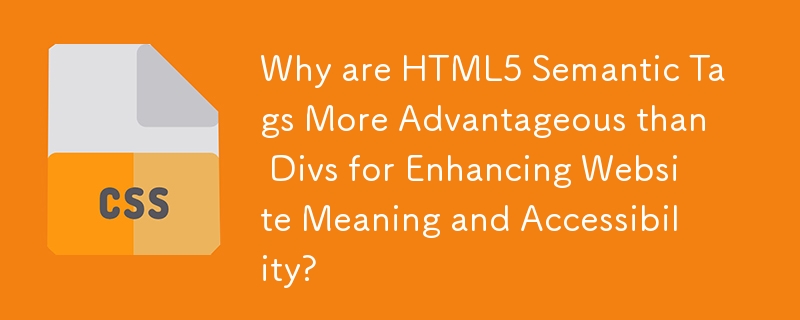 Web Front-end
Web Front-end
 CSS Tutorial
CSS Tutorial
 Why are HTML5 Semantic Tags More Advantageous than Divs for Enhancing Website Meaning and Accessibility?
Why are HTML5 Semantic Tags More Advantageous than Divs for Enhancing Website Meaning and Accessibility?
Why are HTML5 Semantic Tags More Advantageous than Divs for Enhancing Website Meaning and Accessibility?

Why Use HTML5 Semantic Tags over Divs for Enhanced Meaning and Accessibility
While HTML5 semantic tags like headers, section, nav, and article may appear similar to div elements with custom CSS, they serve a crucial purpose beyond presentation. The key distinction lies in their semantic value, which enhances the interpretation and accessibility of web content.
The Importance of Semantics in Web Development
Semantics, as defined by the Oxford Dictionary, delves into the study of meaning. HTML5 semantic tags embrace this concept by providing meaningful names for website elements, conveying the intended purpose of each section. For example, a nav tag clearly indicates navigation elements, while a section tag signifies a self-contained logical division of content.
Benefits of Using Semantic Tags
By leveraging semantic tags, developers create web pages that:
- Improve Machine Readability: Automated processes like search engine crawlers and screen readers can better understand the structure and content of web pages based on the designated semantic tags. This facilitates accurate indexing, accessibility, and context analysis.
- Enhance User Experience: Semantic tags cater to assistive technologies, such as screen readers used by visually impaired individuals. These technologies rely on semantic cues to accurately convey the purpose and relationship between web elements, providing a more inclusive browsing experience.
Examples of Semantic Tag Usage
- Identifying Primary Content: The main content of a web page can be enclosed within a main tag, indicating its significance to search engines.
- Highlighting Emphasized Text: Use the em tag for text that requires emphasis, instructing browsers to differentiate it from surrounding content and allowing screen readers to convey its importance.
Beyond Semantic Tags: Data Interconnection and Knowledge Creation
While semantic tags provide a solid foundation for meaning conveyance, technologies like metadata, ontologies, and resource description languages take it a step further. They facilitate data connections across web pages, enabling the creation of new knowledge and advanced applications.
For instance, consider the Wikipedia pages of Barack Obama, Donald Trump, and Joe Biden. Despite holding similar positions as presidents of the United States, their pages lack semantic descriptions that prevent automated comparisons or the creation of derived knowledge. Utilizing an ontology like DBpedia would enable the representation of their shared attributes and relationships, paving the way for insightful data analysis and discovery.
Conclusion
Embracing HTML5 semantic tags goes beyond aesthetic concerns. It assigns meaningful structure to web content, enhancing its interpretability, accessibility, and potential for data interconnection. By leveraging semantic tags and related technologies, developers can create web pages that are more informative, accessible, and technologically adaptable.
The above is the detailed content of Why are HTML5 Semantic Tags More Advantageous than Divs for Enhancing Website Meaning and Accessibility?. For more information, please follow other related articles on the PHP Chinese website!

Hot AI Tools

Undresser.AI Undress
AI-powered app for creating realistic nude photos

AI Clothes Remover
Online AI tool for removing clothes from photos.

Undress AI Tool
Undress images for free

Clothoff.io
AI clothes remover

AI Hentai Generator
Generate AI Hentai for free.

Hot Article

Hot Tools

Notepad++7.3.1
Easy-to-use and free code editor

SublimeText3 Chinese version
Chinese version, very easy to use

Zend Studio 13.0.1
Powerful PHP integrated development environment

Dreamweaver CS6
Visual web development tools

SublimeText3 Mac version
God-level code editing software (SublimeText3)

Hot Topics
 Create a JavaScript Contact Form With the Smart Forms Framework
Mar 07, 2025 am 11:33 AM
Create a JavaScript Contact Form With the Smart Forms Framework
Mar 07, 2025 am 11:33 AM
Create a JavaScript Contact Form With the Smart Forms Framework
 Adding Box Shadows to WordPress Blocks and Elements
Mar 09, 2025 pm 12:53 PM
Adding Box Shadows to WordPress Blocks and Elements
Mar 09, 2025 pm 12:53 PM
Adding Box Shadows to WordPress Blocks and Elements
 Demystifying Screen Readers: Accessible Forms & Best Practices
Mar 08, 2025 am 09:45 AM
Demystifying Screen Readers: Accessible Forms & Best Practices
Mar 08, 2025 am 09:45 AM
Demystifying Screen Readers: Accessible Forms & Best Practices
 Create an Inline Text Editor With the contentEditable Attribute
Mar 02, 2025 am 09:03 AM
Create an Inline Text Editor With the contentEditable Attribute
Mar 02, 2025 am 09:03 AM
Create an Inline Text Editor With the contentEditable Attribute
 Making Your First Custom Svelte Transition
Mar 15, 2025 am 11:08 AM
Making Your First Custom Svelte Transition
Mar 15, 2025 am 11:08 AM
Making Your First Custom Svelte Transition
 Comparing the 5 Best PHP Form Builders (And 3 Free Scripts)
Mar 04, 2025 am 10:22 AM
Comparing the 5 Best PHP Form Builders (And 3 Free Scripts)
Mar 04, 2025 am 10:22 AM
Comparing the 5 Best PHP Form Builders (And 3 Free Scripts)
 File Upload With Multer in Node.js and Express
Mar 02, 2025 am 09:15 AM
File Upload With Multer in Node.js and Express
Mar 02, 2025 am 09:15 AM
File Upload With Multer in Node.js and Express






